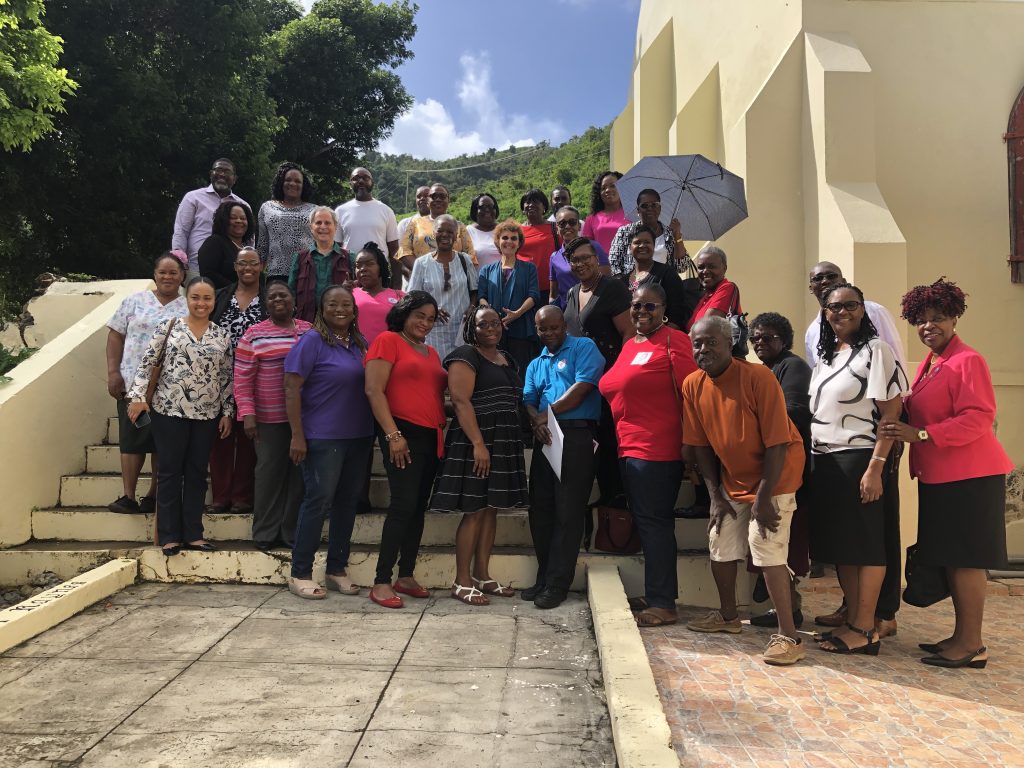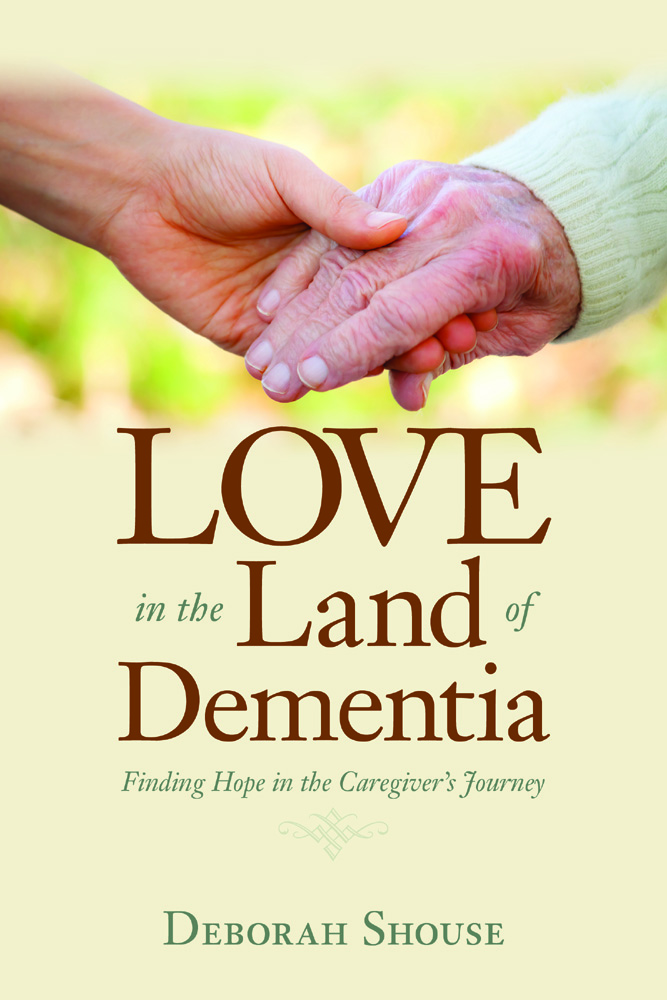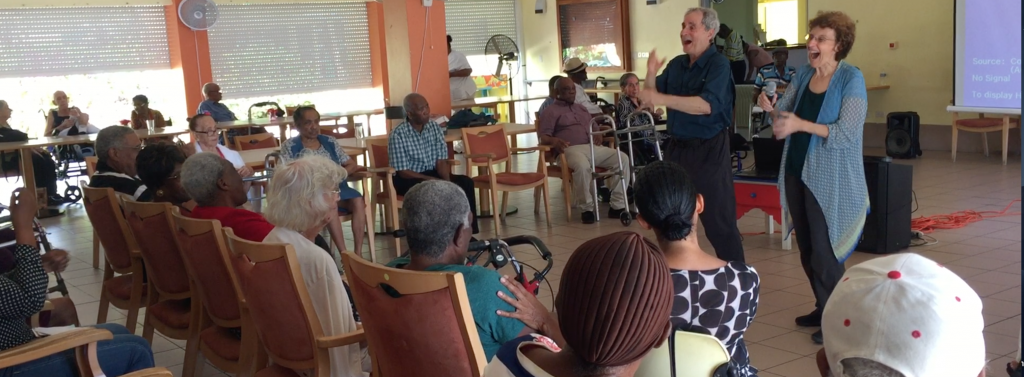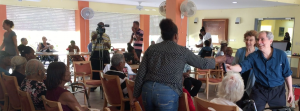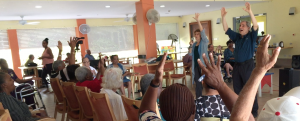Posts Tagged ‘Deborah Shouse’
Presenting to Care Partners in Tortola: The Power of One Person to Make a Difference
The founding of the Virgin Islands Alzheimer’s Association in Tortola, BVI, is about the power of one person to make a difference. It started at a Rotary Club meeting in 2013 when a fellow Rotarian confided in Edna Williams, “I have been diagnosed with Alzheimer’s.”
He told her how hard it was to find support and resources. Edna felt compassion for her friend and others in his situation. As a trained social services worker, human resources consultant, and woman of action, she went to work to remedy the situation. The results: a vibrant Association recognized by Alzheimer’s Disease International. The Association and its many volunteers serve as advocates for people who are living with dementia and their friends and families.
We were honored to spend time with Edna and to share our presentation with a group of family and professional care partners, social workers, and community and spiritual leaders. As we talked about the strength of music to keep us connected, Dawn, the daughter of Edna’s Rotarian colleague, the man who had inspired the founding of the Association, stepped forward to tell us her own story.
For several years, her father had been listless and withdrawn, seldom showing interest in anything. She mourned his father’s dynamic personality and tried many things to lift his spirits and pique his interest. Then she came upon a favorite song of his from years back, a lively tune with a Latin beat.
“When I played that song for him,” she told us, “he came to life. His eyes brightened and he began to mouth, then sing the words. He leaned forward in his chair, wanting to get up and move. It was such a meaningful transformation. The music connected with him and that helped him connect with us.”
Her touching story was a reminder that arts and creativity can go beyond the rational mind and the spoken word and awaken our hearts and spirits.
As we shared ideas for staying connected with each other, regardless of our abilities, our own hearts and spirits were expanded by our time with Edna and her group. It’s wonderful to live in a place of breathtaking beauty. It’s even greater to live in a community where people reach out to help and support their neighbors.
Presenting to Community Members in the St. Martin’s Home, Along with Powerhouse Performer Raymond Jessurun
We knew that Raymond Jessurun was an amazing leader, organizer, and dementia advocate from our previous work with him in Philipsburg, St. Maarten. But we had no idea what a powerhouse performer he was until recently, when we presented with him at the island’s White and Yellow Cross Care Foundation.
On our way to the event, Raymond told us, “We have a mixture of people coming together, people from all over the world, people of varying abilities. We want to invite joy into their lives. We want everyone to connect and have fun together.”Ron and I loved the idea and focused on music and laughter as a common pathway. When we arrived at the care center, which is managed by the White and Yellow Cross Care Foundation, the community area was filled with light: the windows opened to the temperate breeze and lush outdoors. Indoors, in a large and cheerful room, people gathered in a semi-circle. Some had lived in Philipsburg all their lives. Others had relocated from other islands or countries, including Holland, Curaçao, St. Kitts, and Guyana.Raymond opened our session by telling everyone, “I want you to teach Deborah and Ron something about yourselves and about our country.”We all shared specific songs that reminded us of our families. Raymond jazzed us up by sliding into the center of the circle with a rousing a cappella rendition of Come on Let’s Twist Again. After a few bars, people were dancing in their seats. We kept the movement going as we conducted When the Saints Come Marching In, first in a stately tempo, then fast. We talked about the times of the day we liked to sing. Several of the care staff said they liked to sing throughout the day. One woman enjoyed singing in the afternoons. Another sang a poignant favorite of hers, about how she longed for someone to hold at night. She received a heartfelt round of applause.As part of our interaction about music and movement, we showed a video of Drum Safari engaging everyone in percussive activity during one of our KC Memory Cafes. We ended our session by giggling our way through some Laughter Yoga exercises, including drinking a delicious, no-cal, laughter milkshake.As a final treat, everyone serenaded us with a traditional national song, O Sweet Saint Maarten Land. (Link: https://www.youtube.com/watch?v=41capjzf7iQ) The ending stanza captures a taste of this beautiful country, but fails to mention its amazing people:“Oh I love thy Paradise,Nature beauty fairly nice,Oh I love thy Paradise,Nature beauty fairly nice.”
Coming Together to Ignite Hope: Working with Dr. Chawla in New Delhi, India
Our Uber driver in New Delhi was a turbaned Sikh with a long gray beard. A sign hanging from the rear view mirror proclaimed, “This car respects women.” He deftly drove us through the city, navigating the melee wherein four lanes of cars compete in a two-lane space. Inside the NGO, Hope Ek A.S.H.A., the receptionist led us into Dr. Chawla’s office. Dr. Chawla has a rich voice and a magnetic presence. She is the catalyst for this center for caregivers, creating the service because of her own experience with her mother and Alzheimer’s. We were coming together to ignite hope.
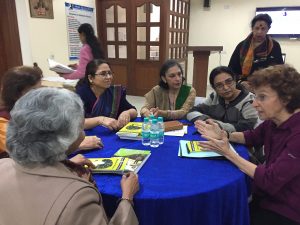
“We know how hard it is for the caregivers,” she says. She and her team help caregivers throughout New Delhi and indeed, throughout the world, educating them, visiting with them and their loved ones who are living with dementia, facilitating support groups, sharing stories and ideas, offering respite and financial support as possible.
For this event, she has gathered a group of doctors, caregivers, support staff, and more. First, some of her team show us activities they do with clients who are living with dementia. These include chanting, deep breathing, gentle stretching, tapping (EFT- Emotional Freedom Techniques), and a lovely heart opening exercise that affirms “We are healthy, we are happy.” They show us painting and games that strengthen memory.
Join us for these interesting exercises:
Then a caregiver from Mumbai Skypes in. Her voice is sad and her face is drawn and pale. She wipes at her eyes as she discusses her issues with her father. Instantly, one of our caregivers steps forward to offer advice. I share ideas with her as well. Then Dr. Sahi, leader of the New Delhi Laughter Academy, guides us in laughter exercises. Within minutes, we are all laughing, even our friend from Mumbai. When the session ends, the worn and weary caregiver has been transformed into an energetic and renewed woman, one who believes there is hope.
That’s is one of the reasons we all came together: our mutual hope and our belief that everyone needs support and a sense of community and purpose.
Experience our New Delhi caregiver’s event by watching this video:
Deborah Shouse is the author of Connecting in the Land of Dementia: Creative Activities to Explore Together and Love in the Land of Dementia: Finding Hope in the Caregiver’s Journey.
Click for Poetry and Help Hundreds
My friend Molly has an exciting opportunity to expand the creative work she is doing with those who are living with dementia. She’s in the running for a small business grant from FedEx. Read this blog to learn more about the meaningful projects she is doing. If you are as inspired as I am, simply click on the link and vote for Molly and Mind’s Eye Poetry: http://bit.ly/1TgpDuJ
A brief silence unfolds while people consider.
“I used to wrap a scarf around my head in the convertible,” one woman says.
The woman sitting next to her smiles. “Scarves blow in the wind,” she says.
Molly mimics the scarf wafting in a breeze.
“If the scarf was music, what kind of music would it be?” Molly asks.
“Jazz,” a man says.
“Rock and roll.”
“Classical.”
Molly, who has an MFA and is the creator of Mind’s Eye Poetry in Dallas, Texas, reaches into her suitcase and brings out a small watering can. She continues the relaxed pacing, asking for impressions, invoking imagination, creating a sense of comfort and connection for this group of people who live in a memory care facility.
After 20 minutes of creative play, Molly takes out a slim book and says, “Here’s a poem about spring that I really like. See what you think.”
She reads the short, rhyming verse and asks for reactions. She then invites the group to contribute to a writing project.
“There are no wrong answers,” she assures them. “I’ll ask something and you’ll say the first thing that comes into your mind. For example, when I say ‘springtime’ what flowers do you think of? ”
“Daffodil, tulip, roses…” the group offers.
Molly writes down each flower and reads it back to the group.
“We have our first line of poetry,” she tells them.
“Imagine where the flowers are, in a vase, in the garden?”
“What colors are they? What time of day is it?”
Every question invites imagination and word-by-word, the poem emerges. After they’ve created three short poems, Molly shows them a piece of art and asks, “What do you see?” She captures their observations and uses their words to create a poem.
Here’s an example of a poem segment created after looking at Oriental Poppies, Georgia O’Keefe’s painting of two large orange poppies.
I see two evening gowns
on a diagonal, flowing.
I see a Scottie dog
prancing in a field of orange.
I see summertime in Santa Fe.
I see a black bird soaring into sunset.
“When I read back their words and say, ‘You all just wrote this,’ it’s very empowering,” Molly says.
For those at home who want to have a session of creative imagining, Molly has these suggestions:
Gather a few interesting objects, such as a recipe book, a nature photo, a pot holder, and one at a time, show them to your partner and ask, “Mom, what do you think about when you see this recipe book?” Give her plenty of time to respond and jot down her answers. If she asks, “Why are you writing?” tell her, “I value what you have to say.”
Soon, you’ll have a collection of words and phrases. You can take a photo of the object along with the poem it inspired and put them together in a book. #
Molly Middleton Meyer is the founder of Dallas-based, Mind’s Eye Poetry. To date, she has facilitated over 600 poems written by people with dementia. Mind’s Eye Poetry has been featured in U.S. News and World Report, the Huffington Post, the Dallas Morning News, Affect Magazine, Growing Bolder Magazine, and on NPR. When Middleton Meyer is not facilitating poetry, she writes her own. Her first book of poetry, Echo of Bones was published in 2014. For more information, contact Molly Middleton Meyer, M.F.A. Poetry Facilitator/Speaker at www.mindseyepoetry.com
Deborah Shouse is the author of Love in the Land of Dementia: Finding Hope in the Caregiver’s Journey.
COMING SOON: CONNECTING IN THE LAND OF DEMENTIA: CREATIVE ACTIVITIES TO EXPLORE TOGETHER
Three Tips for Living Large Inside the Box
How can we all stay connected with our creative spirits during the dementia journey?
I’ve been very inspired by people who are connecting both with care partners and with those living with dementia, through artistic and creative expression. I recently read this blog by Matt Stevens, a designer and illustrator based in Charlottesville, NC. Best known for his MAX100 project, 100 interpretations of the same object (the Nike sneaker). Matt has also worked on identity and branding for clients such as Pinterest, Facebook, Evernote, Dunkin’ Donuts, and the NBA. His thoughts on creativity and repetition seem applicable to the care partner’s journey.
How Rules and Repetition Inspire Creativity
For centuries, artists have been exploring the benefits of working with constraints. Bach composed the Goldberg variations — an aria and 30 variations for a harpsichord — in 1741. Picasso created an 11-lithograph series of bull illustrations in 1945. Matt Stevens reinterpreted the same object in his MAX100 project and has serialized a number of his other works as well. Great artists and designers impose constraints to inspire their creativity.
“I noticed how often I create repetition in my work – systems for myself to operate within,” Matt says. “I asked myself: Why do I create this repetition? Why do I love series so much?”
Limitations force you to be inventive and create new paths.
With Matt’s MAX100 project, he focused on a single image — the iconic Nike sneaker — and reinterpreted it 100 times.
The rules were simple: the shoe had to be in the same position on the page (it couldn’t be turned), and it had to be fundamentally changed. It wouldn’t be enough to add patterns around it: he would iterate on the shoe itself, over and over again.
“The idea is to take something, abstract and change it and let the narrow focus of the project give you a sense of freedom as you move through it. How far could I push it? How much could I abstract it?”
For Matt, this exercise led to a successful Kickstarter that turned into a book, client work with Nike themselves, plus an art exhibition in New York. #
From Deborah.
One of the ways I tried to learn from creative limitation was exploring new ways to answers my mom’s repetitive questions. I also experimented with new ways to bring joy and creativity to our time together in the care home. Even though Matt’s tips are targeted towards the artistic community, I find them thought provoking and hope you will too.
Here are a few more ideas from Matt:
No project happens overnight. Your process for setting a project with the right limitations is important.
- Define the problem
Choose your subject and your challenge. You may be trying to understand a fellow designer’s technique. You may really just love an icon. You may want to learn a new skill. Define the problem and what you will focus on. The MAX100 project, for instance, started as a project for Matt to learn more about illustration.
- Limit your options in solving the problem
“Limited options provide clarity. And when you get stuck, sometimes the answer is not more; but it’s less.”
Impose a structure and set some rules to explore your concept. What rules will you create by? Create a baseline structure to operate within, whether that’s the medium you are trying to learn, or the logo you are trying to explore.
- Iterate, explore, learn, repeat
Don’t get stuck on the unknowns. Don’t be afraid to imitate the styles of people you admire as you go, either: these can set off their own series of explorations. Pick those apart and understand how they work. You may start to see the task in new and unexpected ways, and explore anew from there.
Remember that when you get stuck, sometimes the answer is not more, but less.
To learn more about Matt Stevens, visit
Deborah Shouse is the author of Love in the Land of Dementia: Finding Hope in the Caregiver’s Journey.
A Halloween Surprise
For months, I’ve been working on my book on dementia and creativity. I’ve been so inspired by all the artistic people who know so many exciting ways to connect through creativity.
My mother’s sense of creativity and playfulness thrived in her last years. But there was one other part of her that was also in full force as well. See if you can identify with this Halloween tale that I first shared last year.
Do you remember trick or treating as a kid, racing down the street, dressed as a superhero or a princess or a witch, eager for treats? When I was growing up, I loved the freedom and surprise of that holiday and I continue to love the scintillating spookiness and dramatic dress of the holiday. Here’s a story about a Halloween gift I received in a memory care unit. Click here if you’d like to watch a video of the story or read on, if you prefer the written word. Either way, I hope you’ll “treat” yourself right this October 31.
Warmly,
Deborah
My Caregiver’s Two-Letter Halloween Treat
On my mother’s last Halloween, her memory care unit held a party. Pam, the nurse, brought a basket brimming with hats, shawls, and scarves. Pam set a floppy white hat on Mom’s silvery curls and draped a lacy purple shawl over her shoulders. In her new adornments, Mom looked both puzzled and happy.
But during the “treat” portion of the Halloween celebration, which featured M & M’s and chocolate chip cookies, Mom’s smile was unambiguous. All her life, Mom had adored sweets and her Alzheimer’s had not dimmed her enjoyment.
Then small children paraded through the facility, dressed as princesses, witches, super heroes, and ghosts. Volunteers handed the residents wrapped tootsie rolls.
“For the children,” they said.
Mom smiled at the adorable kitty cats and pirates who chanted “Trick or treat,” in wispy voices, but she did not relinquish her hold on the sweets; she did not share her candy.
“Mom, would you like to give the children some of your candy?” I asked as my mother gripped her treasure.
“No,” she said.
No. The word floated through my mind and I gazed at Mom, my mouth open, my mind euphoric. Perhaps I should have been chagrined at her selfishness but instead I was thrilled that she had actually responded to my question. It was the closest we’d come to conversation in weeks. I laughed with delight. Mom laughed.
For that moment, we were two women, laughing at ourselves, laughing at life, simply laughing. For me, it was a most wondrous and unexpected treat.
*****
Please share one of your unexpected treats.
Deborah Shouse is the author of Love in the Land of Dementia: Finding Hope in the Caregiver’s Journey.
